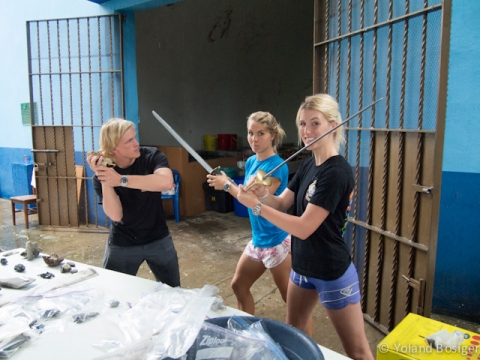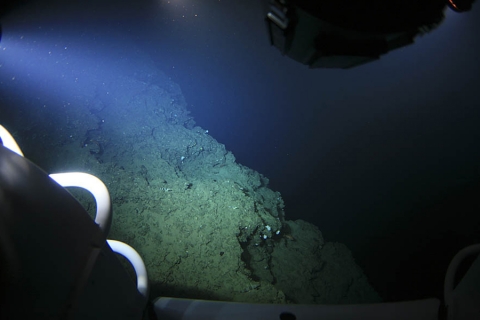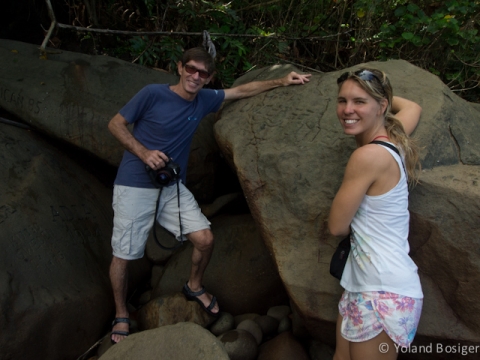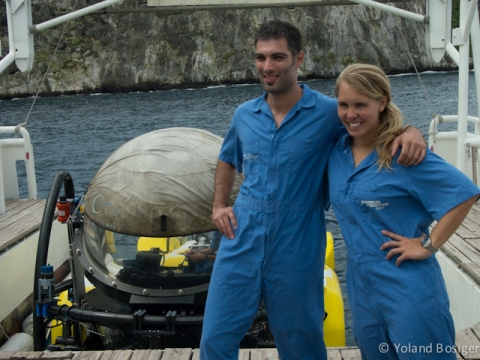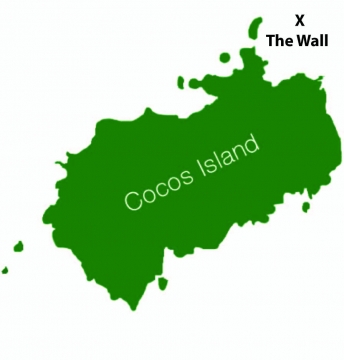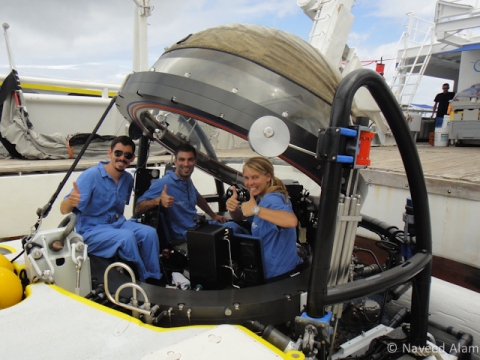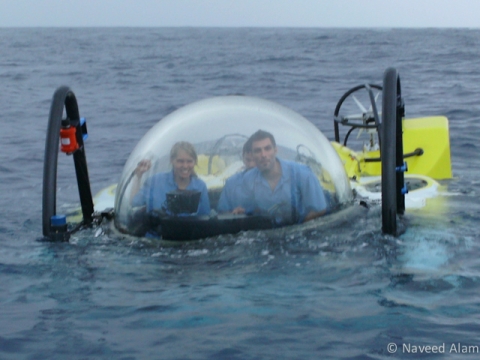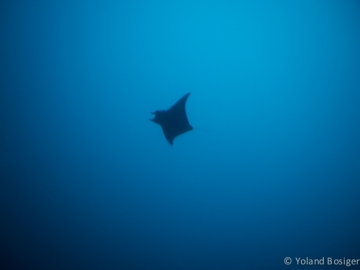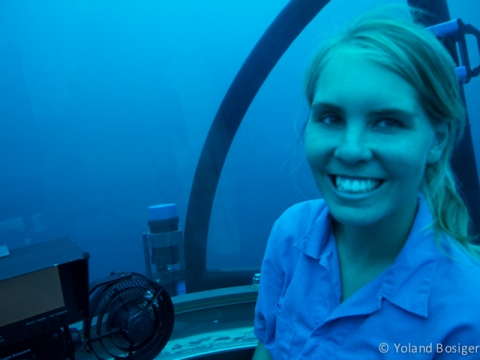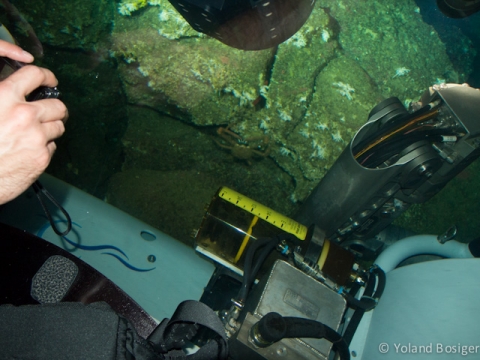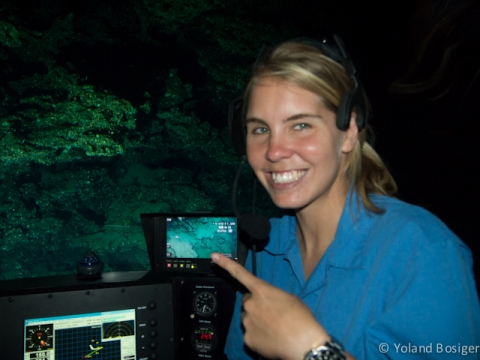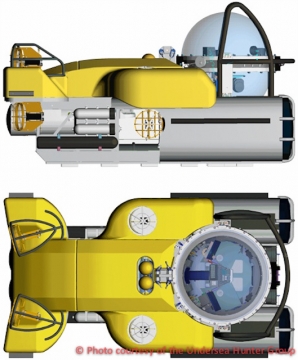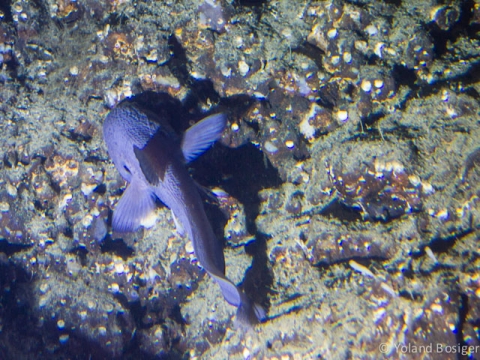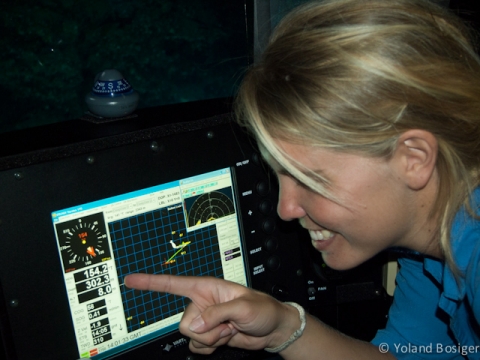Okay just before I launch into my epic submersible adventures, I wanted to just let people know that Megan Cook (USA Scholar) and Oscar Svensson (EU Scholar) have written some awesome blogs about our time at the DEMA awards party and also in the Dominican Republic. If you would like to have a read of them go to http://owussnorthamerica.org/?p=2512 for the Dominican and http://owussnorthamerica.org/?p=2472 for DEMA.
So here goes: Have you ever dreamed of being an explorer? or of going places where few people have gone before? Does the thought to treading the beaten track bore you? and are you itching to get out there and push the boundaries, to delve out of the regular and common place and into the extraordinary? Well a trip on the DeepSee Submersible might just be for you! The deep sea is the least explored place on earth. It is the last frontier of unknown and unanswered and yet ironically it makes up 90 percent of the living space on the planet!
Seeing the deep sea environment has always been a dream of mine and so when I found out that there was a space on the DeepSee Submersible, I quickly talked to Avi Klapfer, owner of the Undersea Hunter Group and pleaded with him to be able to go. Avi looked at me and shrugged “well I was going to ask one of the workers but well you’re here now so go for it”. I tried to contain my excitement as I thanked him, and proceeded to run downstairs and jump around like a complete looney for at least 5 min.
The DeepSee Submersible is a custom built, one atmosphere submarine, capable of carrying three people (including the captain) to a depth of, wait for it……450 m!! The Sub was build with the intention to allow members of the public access to the deep sea (an activity that was previously reserved for scientists and military personnel). In doing so, it was hoped that more people would begin to appreciate the beauty and complexity of this frequently misunderstood environment. See a brief history of the Sub: http://www.underseahunter.com/b169/history.html
Naveed Alam would be my partner in crime for the DeepSee dive and after quickly collecting our cameras we were transferred by small boat to the Argo (mother ship for the DeepSee). There we met our pilot, Felipe and switched into our sweet spacesuit clothing – essential for looking cool and credible in a submarine of course!!! Our dive was going to be at a site called the Wall, situated on the north east side of the island and our dive would take approximately 2 ½ to 3 hours.
We made it to our dive site and the cover of the sub was removed receiving a crystal clear view of the sky above us. It’s sounds strange but it really felt like you were outside with nothing between you, the sky and the water. The DeepSee’s acrylic sphere provides a 360 degree field of vision and completely disappears when emerged, providing photographers and videographers total freedom to shoot.
Slowly we began to descend and the light created a beautiful pastel sphere above us. Both Naveed and I were speechless. I think at that point the enormity of what we were about to accomplish was now more real then ever and we could not get the grins off our faces.
Felipe told us a bit about his work as a submersible driver and turns out that today was his 100th dive. With 99 dives already under his belt, I think we were going to be in good hands. Check out the sub’s specifications: http://www.underseahunter.com/sub-specifications-deep-see.html
“Look, what is that”, said Naveed. There, just above our heads was a large ray of some sort gliding effortlessly above us. We were now at 70m and the light had dissipated dramatically. “It’s a mobula ray,” exclaimed Filipe with excitement in his voice. According to our pilot, Mobula’s are very inquisitive and like to check out the submersible. Sure enough the Mobula glided straight towards the sub doing a graceful sweep over the dome.
Our first stop was on the sandy bottom at about 190 m and we saw a number of deep sea crabs and thread fin bass. From the submersible, the crabs looked to be about 5 cm long but turns out they were in fact about 12 cm long. The rounded dome makes everything look a lot smaller than in reality, constantly catching us out on our length estimations. We then headed over the edge of the shelf onto the wall to find an abundance of life. Scorpionfish, deepwater cup corals both pink and yellow, stylaster corals and octocorals.
At one point, Felipe stopped to take a picture of one of the corals with the high definition still camera mounted on the outside of DeepSee. Take a virtual tour of the sub here : http://www.underseahunter.com/virtual-tour-deep-see.html
This brings us to the original mission of the DeepSee which is to act as a tool for collecting data about the deep ocean. By paying to take a dive, tourists are supporting and providing funding for important research in collaberation with the University of Costa Rica. Every time the DeepSee descends it collects information about the sea temperature, salinity and PH building an invaluable picture of the deep ocean through time. DeepSee also has a fully articulated manipulator arm for collecting samples or retrieving scientific instruments. Amazingly, DeepSee has already been responsible for discoving a completely new family of soft corals (Aquaumbridae). See – http://www.underseahunter.com/n37/deepsee-sub-discovers-new-family-of-coral.html
We dropped further down over ledges and overhangs, to find even more incredible creatures. One of the most memorable was the jellonose fish (Guentherus altivela) which live up to depths of 600 m. These fish have a long flabby body, a bulbous snout (hence the name jellynose) and grow up to 2 m in length. While their skeleton is largely made of cartilage they are definitely teleosts and are not related to sharks.
Our decent continued until finally we saw the depth guage at the front of the instrument panel read 307.2 m Ahhhhh. Naveed, and I did a very restricted chair dance in the sub and then tried to take it all in before it was time to come up. On the ascent Filipe showed us some layers of white rock which were in fact guano buildup from the last ice age. Pretty incredible to think that the water level was once well below this spot
Slowly but surely the light started to increase as we made our way to the surface. It had been an amazing journey and I one I would never forget. I want to sincerely thank Avi Klapfer for giving me the chance to explore this spectacular concealed world, and the Scholarship Society for allowing me come and experience it. Also quick thanks to Matthew Meir for giving me some great submarine photo tips prior to my arrival. Stay tuned for adventures at DAN Divers Alert Network.

